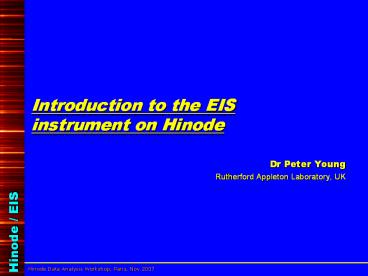Introduction to the EIS instrument on Hinode PowerPoint PPT Presentation
Title: Introduction to the EIS instrument on Hinode
1
Introduction to the EIS instrument on Hinode
- Dr Peter Young
- Rutherford Appleton Laboratory, UK
2
Basic facts
- EIS EUV Imaging Spectrometer
- Successor to CDS on SOHO
- Covers two wavelength bands 170-211 Å, 246-292 Å
- Principally for coronal spectroscopy
- PI institutes MSSL (UK), NRL (USA), NAOJ (Japan)
- PI Prof Louise Harra (MSSL)
3
Instrument layout
Multilayer coating gives high reflectivity in
EUV
Aluminium filters block out visible light
Single mirror for focussing improves throughput
of telescope
Back-thinned CCDs directly sensitive to EUV
radiation
4
Field of view
N
A coarse offset can also be applied to offset EIS
from the other instruments
EIS (576x512)
E
W
SOTNFI/SP (328x164)
SOT BFI (205x102)
XRT (2048x2048)
5
CCD image
2048 pixels
1024 pixels
CCD-A Long wavelength 246-292 Å
CCD-B Short wavelength 170-211 Å
6
Slit options
- Four slits available, defined by their width
- 1 and 2 slits are for spectroscopy
- 40 and 266 slits for imaging
1
266
7
Using wide slits context images
Context slot raster, Fe XII 195 Duration 3min 20s
2 slit raster, Fe XII 195 Duration 22min
8
Using wide slits movies
- The most clean emission line for the 266 slit
is Fe XV 284.16 (2 million K)
EIS wide slot movie Fe XV 284.2
(logT6.3) Courtesy H. Warren (NRL)
9
The EIS spectrum
- Spectrum dominated by coronal ions (iron,
particularly) - Few useful transition region lines, but not
strong
Young et al. (2007, PASJ, in press)
10
Telemetry limitations
- The EIS data rate is limited to around 50 kbits/s
- Data are routinely compressed using DPCM
(lossless) by a factor of around 3 - JPEG (lossy) compression is also allowed
- Despite this, complete CCD data can not be
obtained routinely - Specific wavelengths (emission lines) must be
chosen - reduced spatial coverage along slit (solar-Y)
11
Science capability
- Transition region lines
- Coronal iron lines
- Flare lines
- Density diagnostics
- Line width and velocity maps
12
Transition region lines
- EIS spectra are dominated by coronal iron lines,
but there are a number of useful transition
region lines
Density in loop footpoints Young et al. (2007,
PASJ)
13
Coronal iron lines
14
Flaring loop (17 Dec)
15
Spectroscopy
- Emission line diagnostics come in two types
- Study of shape and position of emission lines
- yields plasma velocity, broadening parameters
- Study of emission line strengths
- yields temperatures, densities, abundances,
emission measure - requires detailed atomic data
16
Doppler shifts
- Each emission line has a standard position (the
rest wavelength) - Shifts from this position imply motion of the
plasma - blueshifts towards the observer
- redshifts away from the observer
Blueshift
Redshift
17
Line width diagnostics
- The width of emission lines can be written in
velocity units as - The components of ?v are written as
- where
- ?vI is the instrumental width
- 2kT/M is the thermal width
- ? is the non-thermal velocity
18
Line width and velocity maps
- Active region map
- Fe XII 195.12 Å
- 2006 Dec 2
Intensity
Velocity
Width
19
Close-up of loop line width
20
Close-up of loop velocity
21
Caution non-Gaussian profiles
- Line profiles are not always Gaussian
22
Density diagnostics
- Certain emission lines from particular ions have
ratios that are sensitive to the plasma density - EIS is the first solar UV instrument to routinely
allow high precision density measurements - high effective area
- access to best coronal density diagnostics
23
Density maps
- The high quality of the EIS data make density
maps easy to generate - Big improvement over SOHO/CDS density maps
24
Best density diagnostics
Ion Ratios
Fe XII (logT6.1) ?186.88 / ?195.12 ?196.64 / ?195.12
Fe XIII (logT6.2) ?196.54 / ?202.04 ?203.82 / ?202.04
25
Instrumental effects to be wary of
- There is a spatial offset in both X and Y between
the two EIS CCDs - X 2 pixels, Y 15-20 pixels
- The line centroids vary by around 60-70 km s-1
through an orbit - Line centroids and widths vary along the EIS slit
- The EIS slits are slightly tilted relative to CCD
- There are a number of warm and hot pixels on the
detector - There are a few dust particles on the CCDs
- affects Fe XI 188.23 and Fe XII 193.51
- Image wobble (satellite instrument) leads to
strange effect in raster movies
26
EIS observations
- Basic observation units for EIS are called
studies - Different studies have unique acronyms there are
over 220 - e.g., COMSCI_AR3, PRY_footpoints_v2, SYNOP001
- Studies actually comprise one or more rasters
- A raster can be, e.g.,
- a scan of a region with the narrow slit
- sit-and-stare with narrow slit or wide slit

